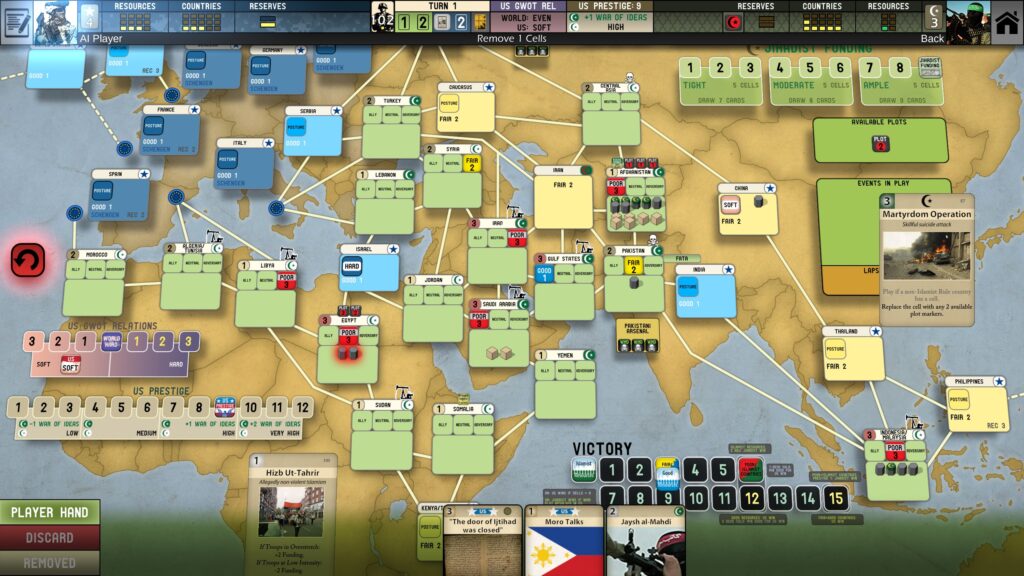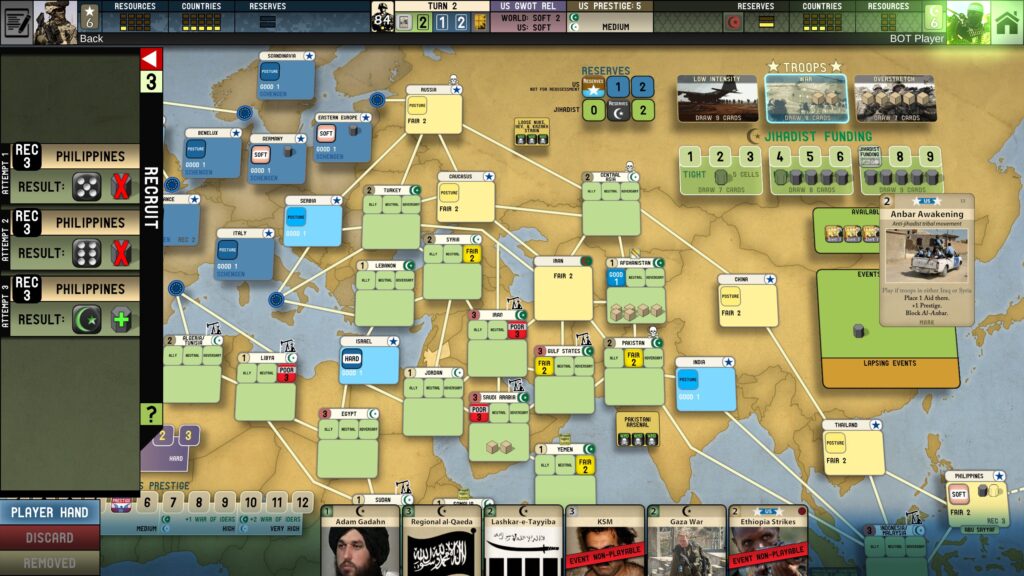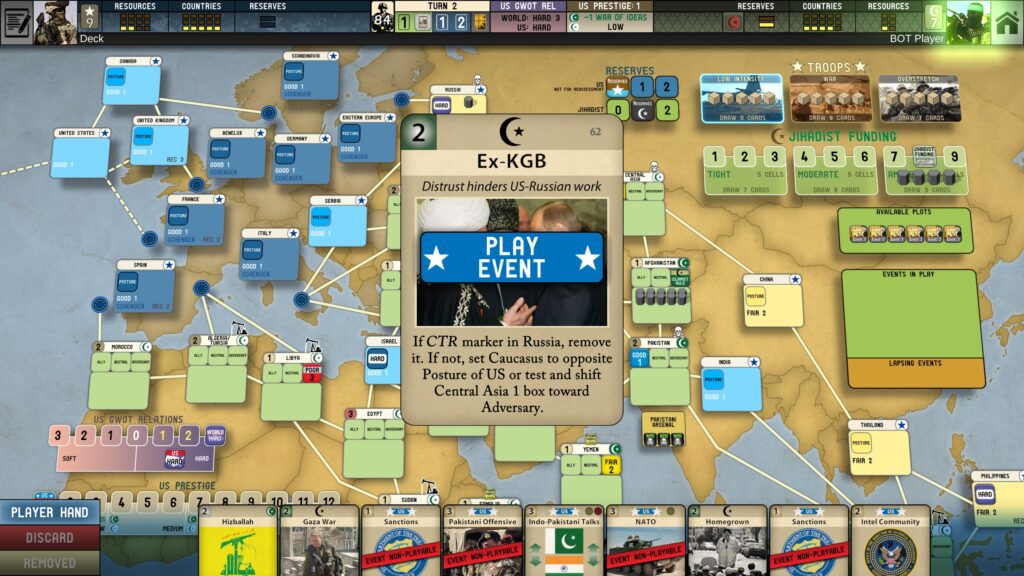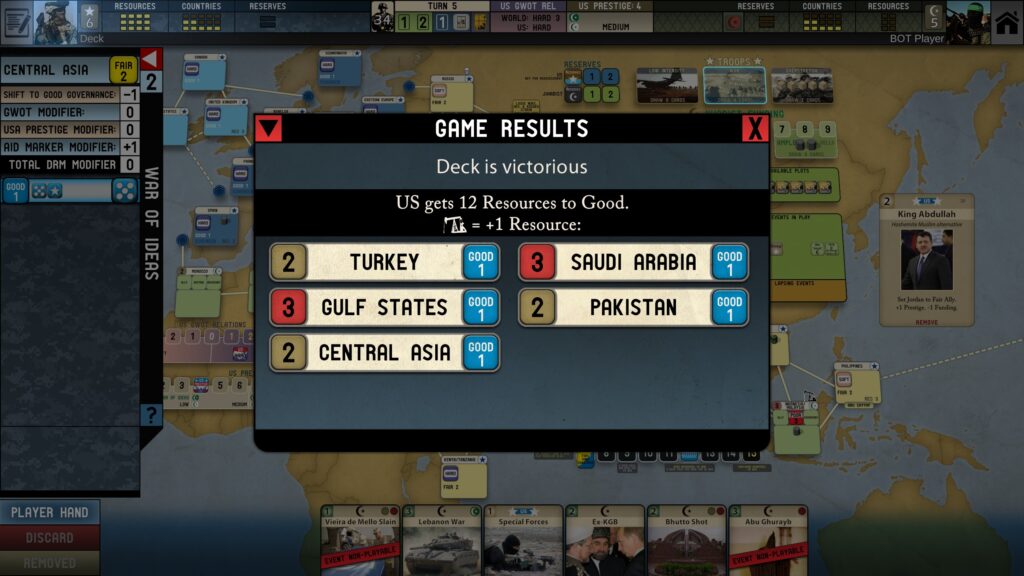
I own a copy of the Twilight Struggle boardgame and though it mostly sits unplayed, I’ve always admired how it portrays real world history in terms of game mechanics. I was naturally intrigued when GMT Games later published a game about the US War on Terror using some of the same mechanics. This was long after I’ve stopped playing boardgames so I had to wait until this digital version to check it out. I had no illusions about the digital version being actually enjoyable as I know this should really be played against real people. I only really wanted to learn and understand the mechanics and in that I was satisfied enough.
As stated, this takes place in the immediate aftermath of the September 11 attacks. Afghanistan is under the control of the Taliban and the US population is clamoring for vengeance. This two-player game lets you take control of either the United States or the Jihadists, each with mutually opposing goals. The board represents a map covering Europe, Africa and Asia, encompassing countries deemed to have a significant Muslim population. The many counters to keep track of US troop deployments, Jihadist cells, resources and sentiment are reminiscent of wargames but there is no real direct combat here. The main conflict is between the two competing ideologies as both sides vie for influence over the Muslim countries of the world. The US player mainly wins by bringing enough Muslim countries up to a high level of governance. The Jihadist player wins by bringing them under Islamist rule. It’s possible to win by eliminating all terror cells from the map or pulling off a large terror attack on US soil but these seem difficult to accomplish in practice.

Though this game superficially looks like Twilight Struggle and is inspired by it, it only really retains one of its main mechanics. Gameplay is centered around a deck of cards that represent historical events. You can play the cards either for the event it represents or for its resource value. The twist is that if you play a card of the opposing side for its resource value, the event takes place anyway so a key part of the strategy is to play it only when it is least harmful to you. Pretty much everything else is different and there are a lot more dice rolls that are used here to determine the success of different actions. You consult various charts to work out the results and as a whole this game is probably more complex. Finally the options and actions available to each side are completely different, making this an asymmetric game. I never had much trouble understanding Twilight Struggle but working out the consequences of different actions and how to get into and out of different situations was quite tough for me. For example, the Jihadist player will naturally want to foment plots. Yet precisely what a plot actually accomplishes when not blocked by the US player depends not only on its strength but in which country it is resolved. It’s a very unintuitive game to learn.
This boardgame, even in its digital form, is best played with other people. I’m never doing that so I have to be contented with just the AI. This version actually only comes with an AI for the US side. If you play as the US against the Jihadists, you actually use a Bot that takes actions based on a fixed flowchart. To compensate for that, the Bot is given an advantage in that the events on the US cards it plays are never executed. It seems to me that beating this bot is actually quite difficult due to this rule as it is rather implacable and single-minded about recruiting and spreading Islamist rule as much as it can. Actually playing against the AI for the US was quite easy to me as it can play cards for their effects and mostly does so poorly. It seemed unwilling to deploy troops to perform a regime change even when it was necessary to avert a loss, preferring to concentrate on converting Muslim countries to good governance. I’m sure there’s more complexity in it that I’ve missed and that it’s possible to develop a consistent strategy to beat the Jihadist Bot but I didn’t want to spend too much time on it after learning the system.

From what I can tell, this actually does make for a reasonable simulation of the War on Terror, but I just don’t find it much fun. As the US, hunting the Jihadists feels just like playing whack-a-mole as it should. You can kill exposed cells readily but the Jihadists can just as easily recruit more. The most important resource is Prestige which greatly influences how easily you can sway other countries. You can easily overthrow Islamist regimes but getting your troops out again is another matter. Playing as the Jihadists, you just have to be persistent and focus Jihad actions on one country at a time. It’s helpful to sneak cells into the US and Europe when you can to force the US player to spend time and resources to take down cells and unravel plots, but that’s not how you actually win. Always remember what the victory conditions are. You really only need to bring a handful of countries to good governance for the US, or to Islamist rule for the Jihadists, to win.
My problem is that there is so much randomness and card combos are so powerful. The standard roll to change Prestige can result in huge swings for the US player so you really only want to risk it when your Prestige is already low. The War on Ideas roll to improve governance depends on a die roll and it’s pointless to attempt it when your Prestige is low and the US posture is out of line with world opinion. For the Jihadists, the success of almost every action depends on a die roll. Moving cells, using them to perform any action. The great thing is that your actions are cheap in terms of resources so you just have to spam actions even though that puts cells at risk. Finally you must always be aware of card combinations. An untested Turkey can be turned into a US ally at good governance with a two card combo! The US player can drop from high prestige to low prestige from a two card Jihadist combo if US troops are occupying Afghanistan! It’s kind of crazy how far the situation can swing from a single play like that.

Anyway as satisfying as it was to finally get a chance to learn the rules and test them out, this wasn’t a boardgame that I really liked. I wouldn’t say no to playing this in person but on the whole I found Twilight Struggle to be a much more intuitive and enjoyable game. There is so much randomness and so many wild swings. Even the distribution of the cards is random as you get one single big deck instead of different cards that are added into the deck at different phases. My impressions pretty much match the consensus that it’s an average game at best and nothing at all like the classic that Twilight Struggle is.